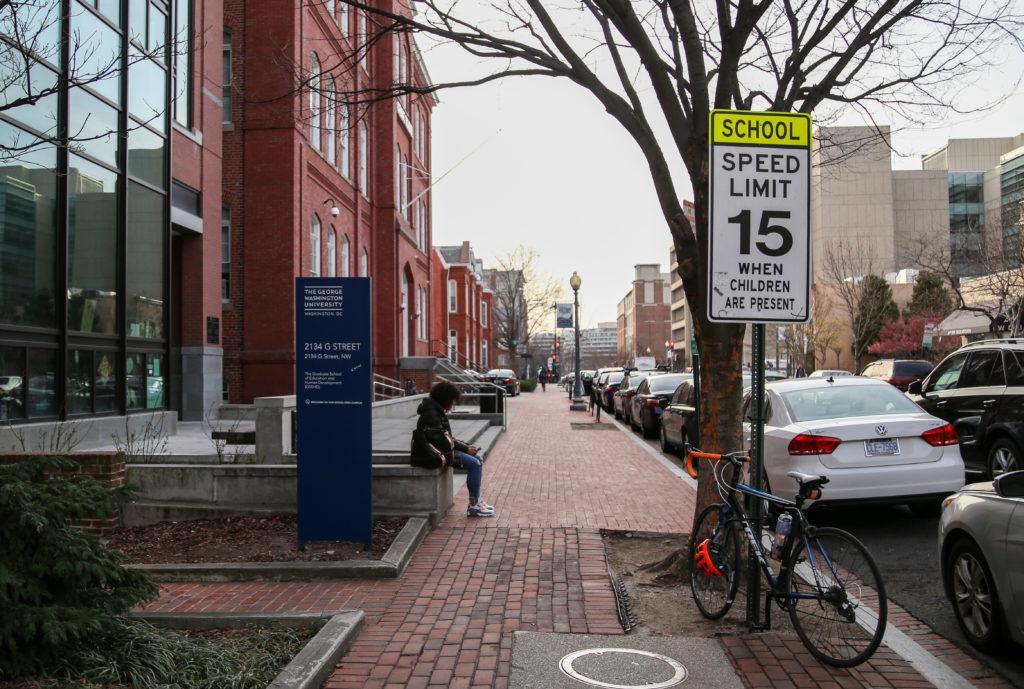A new D.C. Department of Transportation proposal would lower the speed limit around residential areas and schools at certain times, including the School Without Walls on G Street.
Community leaders said reducing the speed to 15 mph from 25 mph from 7 a.m. to 11 p.m. weekdays would increase pedestrian safety around locations like the School Without Walls. But experts questioned the speed limit’s effectiveness in slowing drivers down.
The proposal was adjusted after DDOT received criticism a year ago for a proposal that called for reduced speeds 24/7, The Washington Post reported. Experts said DDOT’s proposal falls in line with a campaign from Mayor Muriel Bower’s office that seeks to eliminate traffic fatalities by 2024.
Maura Danehey, a DDOT public affairs specialist, said experts agree that the intensity of crashes are influenced by vehicles’ speeds.
“Lower speeds make streets safer for all users,” she said. “For people walking or biking, lower motor-vehicle speeds mean that when a mistake happens, it is less likely to be deadly.”
Danehey said DDOT will find potential areas that need speed reductions on short sections of roadway by using safety data and talking with people about their communities. Placards accompanying new signage and public outreach by DDOT will alert people to the changes, she said.
She declined to say how much adding new signs would cost DDOT but said the department’s budget can handle the costs.
Patrick Kennedy, the chairman of the Foggy Bottom and West End Advisory Neighborhood Commission, said the one-way wide roadway on G Street – where School Without Walls is located – makes drivers comfortable going faster. Lowering the speed limit will discourage speeding and traffic collisions, he said.
“There is no excuse for people to be speeding,” he said. “I think lowering the speed will help prevent injuries.”
Kennedy said creating a crosswalk in front of the fire station on the street, installing speed cameras and adding bicycle lanes to narrow a wide street like G Street would make drivers follow the speed limit.
If the D.C. Council approves the proposal, Kennedy said the ANCs can help make residents aware of the changes with social and local media outlets.
DDOT will accept feedback on the proposal until March 6, according to The Post.
Traffic collisions involving pedestrians are not a new concern to the Foggy Bottom Campus. A student was struck in a hit and run incident at the intersection of 20th and G streets in October, and less than a month later, a car hit a woman near 23rd and I streets.
Twenty-eight traffic fatalities were counted in D.C. last year, according to Metropolitan Police Department statistics.
Maralee Csellar, a University spokeswoman, said the DDOT did not contact GW about speed limit changes on or around campus.
Experts said while the lowered speed limits are a step in the right direction, DDOT should also work on other safety measures, like making crosswalks more visible and teaching community programs on traffic safety.
Richard Balgowan, an expert witness in highway and municipal engineering for Robson Forensic – a law firm specializing in forensic engineering – said he infrequently sees a 15 mph speed limit.
“There are better ways to do this,” Balgowan said. “The driver of a vehicle will always drive at a speed that is comfortable and safe for them.”
Speed cameras and traffic calming – or physical constructions like speed humps and bike lanes at intersections – force drivers to slow down in a way that speed limit signs do not, he said.
“Traffic calming will do it for sure, unless they have police cars parked outside,” he said. “I don’t believe at all that just lowering the speed limit will change anything.”
Anthony Green, the director of public policy for Safe Kids Worldwide in D.C., said lowered speed limits might not effectively stop people from speeding as well as visible law enforcement officers would. Still, he said he supports the proposal if there is time for the public to learn about the changes and if the proposal defines what residential areas are.
Green said the chances of death or a serious injury for a pedestrian are decreased when speeds are lowered to 15 mph, and blinking yellow signs and crosswalks around schools in addition to speed limit signs would make the area more safe.
“If you’re walking across 23rd Street and a car hits you going at 35 mph, you’ve got a really good chance of having your next destination be the GW Hospital emergency room, and I don’t want that to happen,” he said.





